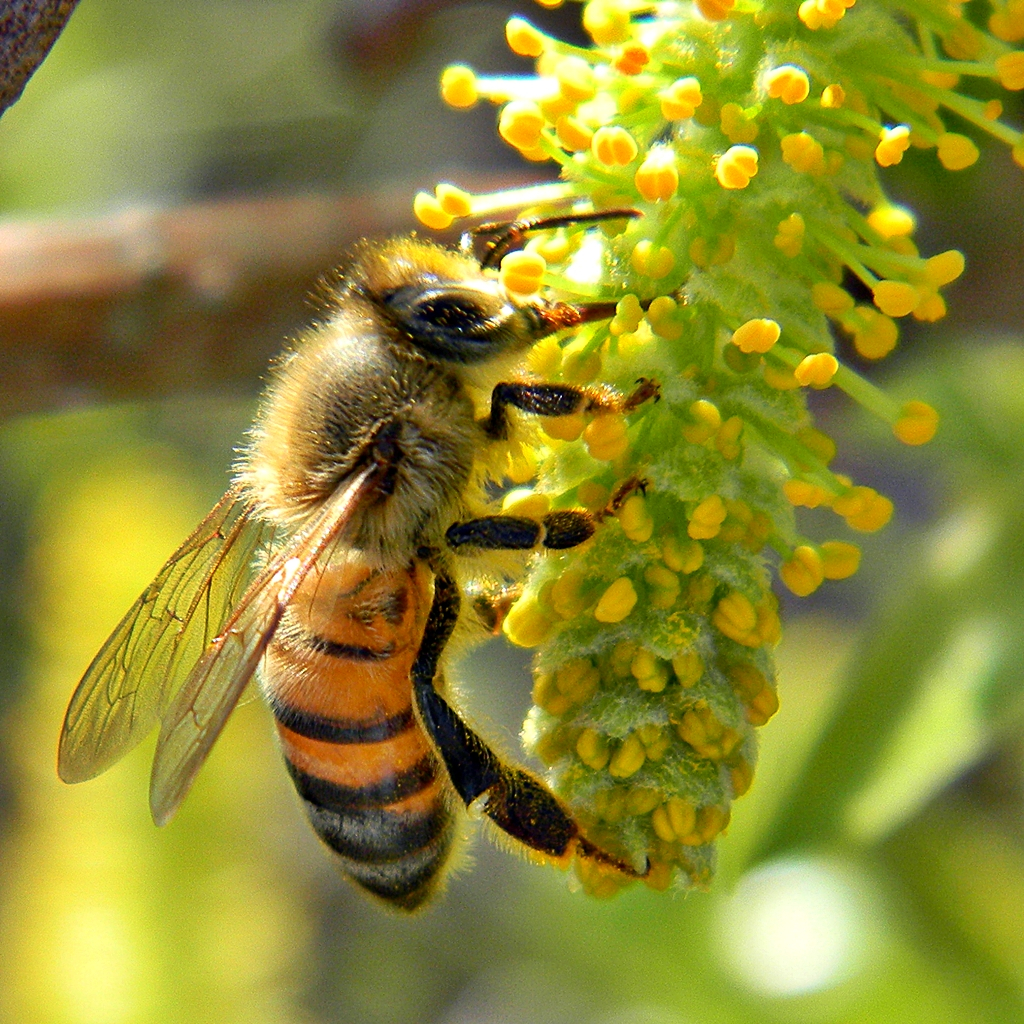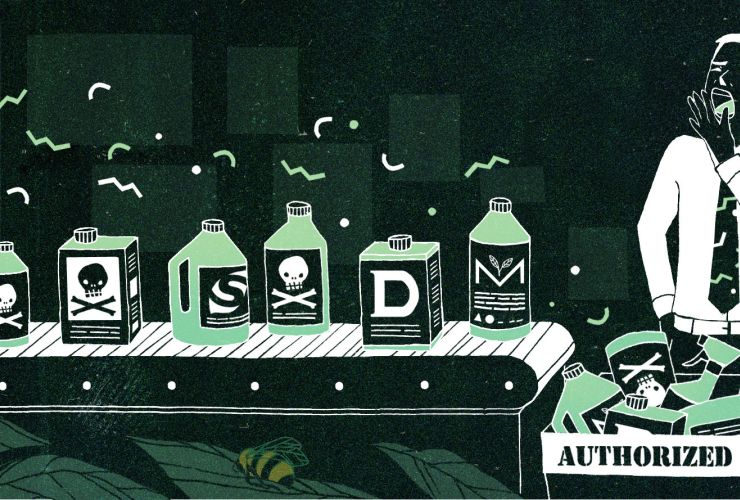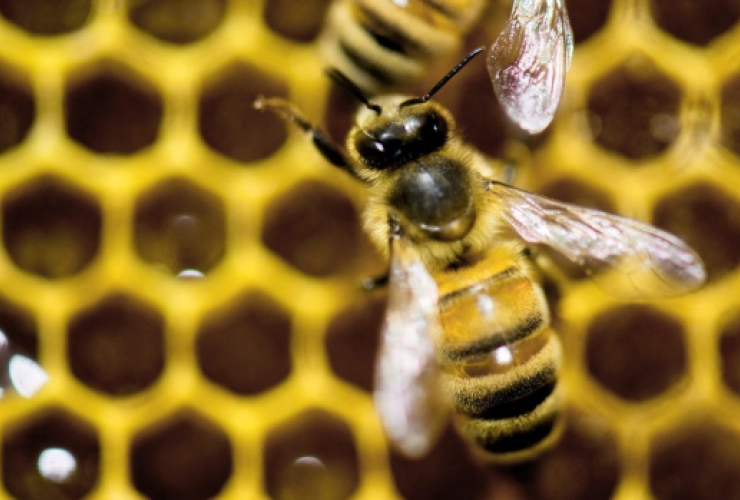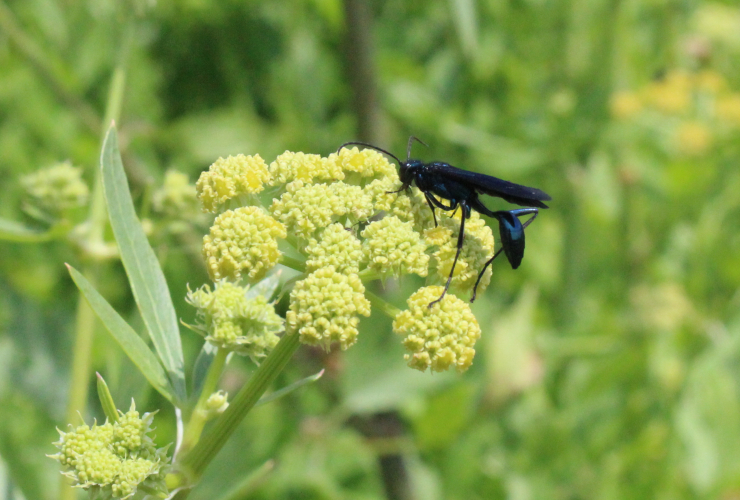Part 2 of a two-part investigation into the regulation of pesticides in Canada. Part 1 can be read here
Dr. Paul Winchester’s passion is delivering healthy babies.
In 2001, he moved to Indiana to work at a hospital based in Indianapolis. But he soon grew alarmed at the high number of premature babies and birth defects he was seeing among newborns. “(From 1999 to 2002) Indiana had more birth defects than the rest of the country,” says Winchester, who is now director of his hospital's neonatal intensive care unit and a professor of pediatrics at Indiana University’s school of medicine.

Winchester began looking for the cause of the birth defects, convinced they were being triggered by an environmental contaminant. “It needed to be a contaminant that can be seen in just about everyone,” he explains, “something that would have affected the whole state. And atrazine fits that bill.”
Indiana is smack in the heart of America’s corn belt. And corn farmers spray their crops with the herbicide atrazine to kill weeds. Manufactured primarily by the Swiss agribusiness conglomerate Syngenta AG, atrazine is one of the world’s most popular herbicides – and the one most commonly found in drinking water in the US, and probably worldwide. “We find that drinking water in Indiana is almost never free from atrazine,” says Winchester.
Winchester felt atrazine might be causing birth defects because the number of cases increased during the period when atrazine was sprayed most heavily on crops – from April to July. During those critical months, surface-water concentrations of pesticides and other agricultural chemicals rose. “We, in a sense, discovered the tip of an iceberg of correlations between pesticides and adverse outcomes,” notes Winchester.
He began writing papers for medical journals linking atrazine to birth defects. Winchester’s research was also used in a lawsuit launched by Stephen Tillery, a St. Louis, MO-based lawyer, who sued Syngenta in 2004 on behalf of Illinois towns and Midwest water districts, claiming atrazine had contaminated their water supplies. This lawsuit was settled in 2012 for (US) $105-million without going to trial – and after Tillery got access to Syngenta’s internal files. “It's unbelievable,” remarks Tillery. “I mean, imagine why somebody would pay you one hundred per cent of your damages plus your fees? Why would they do that? I mean, they didn't want me to have a trial.”
But it’s not only birth defects atrazine is linked to: it's been fingered for wiping out frog, fish and other aquatic wildlife populations, causing sexual abnormalities in amphibians (and possibly people), and of triggering various forms of cancer. In fact, the EU banned atrazine in 2003 due to its contamination of groundwater.

However, about 500,000 kilograms of atrazine is sprayed on crops in Canada every year. This past March, the environmental groups Environmental Defence and Équiterre found atrazine in Toronto and Montreal's tap water at levels above EU standards (although below Canadian standards).
What is the Pest Management Regulatory Agency (PMRA), the federal regulator of the pesticide industry, doing about atrazine?
As noted in Part One of our investigation into the PMRA, critics of the agency say it turns a blind eye to evidence that popular herbicides and insecticides are causing massive impacts on the environment and to human health. They accuse the PMRA of, in effect, being “captured” by the very agrochemical companies it’s supposed to be overseeing, such as Syngenta, Bayer, Dow-Dupont, Monsanto and BASF.
“We find (the PMRA) does not have a transparent decision-making process,” observes Annie Bérubé, director of government relations for Équiterre, a Montreal-based environmental organization. “Most of the information they consider when they review a pesticide is protected by confidential business information, so we have no way of knowing how they render their decisions.”

In this story, we investigate what a growing body of scientific evidence says about three of the most popular pesticides sold in Canada – and how the PMRA replied to these concerns.
Atrazine - a herbicide linked to frog deformities and cancer
Atrazine was invented in 1958 and is sprayed on crops such as corn, maize, pine, canola and sugarcane to kill weeds. Currently, 13 products containing atrazine are permitted for use in Canada.
Back in 1994, the US Environmental Protection Agency (EPA) ordered a scientific review of atrazine.
One of the people recruited to examine the herbicide was Tyrone Hayes, a Harvard-educated biologist who works at the University of California, Berkeley. With the backing of Syngenta, Hayes began studying atrazine’s impact on amphibians. His first experiments revealed that male tadpoles developed less muscle surrounding their vocal cords when exposed to atrazine, and Hayes concluded it reduced testosterone. But Syngenta was unhappy with Hayes’ results, so he stopped taking their money but continued his investigations.

Hayes eventually discovered atrazine had a tremendous impact on the sexual organs of frogs: he noticed that some could not be clearly identified as male or female, while others had multiple and deformed testes.
By now Hayes has written numerous papers revealing, among other things, that atrazine is causing frogs to become hermaphrodites when exposed to the chemical at levels 30 times below what the EPA permits in water. He concluded that atrazine could be why frog populations are in decline – a worldwide problem. “Atrazine is an endocrine-disruptor,” explained Hayes when I interviewed him last year. “In the human population, that means that, because of the decline in testosterone and the increase in estrogen—now it's associated with things like breast cancer, prostate cancer, decreased sperm count and infertility. It's associated with a number of birth defects, including genital malformations in males.” Given that atrazine is the number one contaminant in drinking water, “then it's impacting humans,” insists Hayes. “And the data all supports that.”
Hayes’ concerns have been confirmed by other scientists. Last year, a 518-page, peer-reviewed risk assessment of atrazine emerged from the EPA, hand-signed by six of its scientists. It said, based on hundreds of toxicity studies, and over 20 years of surface water monitoring data, that “aquatic plant communities are impacted in many areas where atrazine use is heaviest, and there is potential chronic risk to fish, amphibians, and aquatic invertebrates in these same locations. In the terrestrial environment, there are risk concerns for mammals, birds, reptiles, plants and plant communities.”
Warren Porter, a zoologist at the University of Wisconsin-Madison has been studying atrazine since the ‘90s and links it to birth defects in infants, along with other impacts. "Atrazine is a molecular bull in a china shop, and the china shop is you,” Porter has said. He says atrazine alters sexual hormone levels, and the effects of that, especially at the embryonic stage, can be life-threatening or have life-long impacts, including long-term chronic inflammation and chronic disease. Porter also maintains there is a possibility that the growing population of transgender people is linked to atrazine and other pesticides. “It's pretty apparent that a lot of our sexuality is being shifted and altered,” says Porter.

Other scientists have tied atrazine to menstrual cycle irregularity in women, hormonal disruption, small birth size among infants and compromised nervous systems. In 1999, the World Health Organizations’ (WHO) cancer research panel, the International Agency for Research on Cancer (IARC), found evidence atrazine is a carcinogen among animals – but not enough evidence it was a carcinogen among people (although other studies have found such a link).
Syngenta, meanwhile, points to other studies that suggest atrazine has no adverse impacts on frogs and, when consumed by people, is in such small quantities that it does not affect their health. "No one has, ever will, or ever could be exposed to enough atrazine in the natural environment to affect their reproductive health," the company says.
PMRA approves atrazine despite concerns
In Canada, atrazine buildup is now thought to be a prime cause of the near extinction of a fish called the copper redhorse — the only vertebrate unique to Quebec. The late Joe Cummins, a professor of genetics at the University of Western Ontario in London, blamed the decline of both the East Coast fisheries and Great Lakes wetlands on atrazine washing from cornfields into groundwater, streams and rivers.
Health Canada says atrazine contamination has been reported in B.C., Manitoba, Nova Scotia, Prince Edward Island, Quebec, Ontario and Saskatchewan. More recently, atrazine has been detected in 11 per cent of groundwater samples across the country.
Yet, in Canada, the government's so-called “safe” level of atrazine for water is 5 parts per billion, which is 50 times higher than allowed in the EU, and 40 per cent higher than the US.
So, what has the PMRA done about such concerns regarding atrazine?
In 2013, the agency began a review of the herbicide. But it was a limited one, only looking at its impact on groundwater and not on human health or wildlife. Says Bérubé: “They refused to do a comprehensive health and environmental assessment of atrazine.”
This past winter, the PMRA announced the results of its review, saying atrazine would continue to be sold in Canada. But environmental groups complained about the limited nature of this review. As a result, the PMRA agreed to do a broader look to consider its health impacts - which won't be completed until 2020. "The (Pest Control Products Act) says a review has to be done in a timely fashion," says Karen Ross, Équiterre's manager of pesticides and toxic substances. "Seven years (to review atrazine) cannot be viewed as timely."
Neonicotinoids - designed to kill insects
In the summer of 2009, 12 French and Swiss entomologists and ornithologists met at Notre Dame de Londres, a village in the south of France. They were guests at the home of Maarten Bijleveld van Lexmond, a retired Dutch biologist, and had come together over alarm about Europe’s collapsing bird and insect populations. “I live part of my time in the south of France – an immensely rich region of biodiversity,” says Bijleveld van Lexmond. “I saw everything disappearing. I began to wonder why.”
The scientists soon concluded a group of pesticides called neonicotinoids (also referred to as neonics) were responsible for the declining bird and insect populations. Developed by the German agrochemical and pharmaceutical giant, Bayer AG, in the 1980s, neonics are currently registered in more than 120 countries, with a global market of (US) $3-billion.
Today, nearly all corn and one-third of soy grown in the US is treated with neonics. A big development for Bayer was when they began coating seeds with neonics: this made the actual plants grown with the seeds toxic to insects. In Canada, more than 300,000 kilograms of neonics are used on Canadian crops every year.
Bijleveld van Lexmond’s group created the Task Force on Systemic Pesticides (TFSP) to research neonics, assembling 30 independent scientists to peruse 1,121 peer-reviewed studies. In 2014, they published their conclusions, maintaining that adverse impacts on a wide range of non-target organisms in terrestrial, aquatic, wetland, marine and benthic habitats was linked to neonics. By then, the EU had banned neonics for use on flowering crops.
Neonics are also considered responsible for collapsing bee hives across North America. Bees are vitally important to food production, given they pollinate the crops of three-quarters of all food consumed. (Bayer referred questions about neonics to CropLife Canada, a lobby group for the agrochemical industry, which stated that problems with bee colonies are related to mites or bad weather and not neonics.)
In parts of Canada, beekeepers were seeing significant collapses of their colonies, especially starting in 2012, when there was a massive die-off. By the winter of 2013-’14, 58 per cent of bees in Ontario did not survive the winter, while other provinces lost on average about 19 per cent. In the States, it’s the same story: In California alone, honey production has fallen by a half in recent years, while the bee population dropped by 70 per cent in Iowa.
Yet the PMRA’s approach to neonics has been highly controversial.
Since 2003, the Auditor General of Canada has conducted three audits of the PMRA. The biggest issue these investigations found was how the PMRA allows agrochemical companies to sell pesticides without the companies having produced all the necessary health or environmental data. Instead, the PMRA hands out “conditional registrations”, on the condition the companies will provide the missing data in the future.
The one class of pesticides where the PMRA has handed out the most conditional registrations to agrochemical companies is neonics. And among the missing data is the insecticide's impact on bees.
In fact, by 2015, of Canada’s 80 conditionally registered pest control products, 36 were neonics. Between 2008 and 2015, the number of conditionally registered neonics increased by 80 per cent (from 20 products to 36). “The problem with the whole conditional idea is that something (in the data) has not been confirmed,” explains Doreen Deveen, one of the auditors who investigated the PMRA. Which could mean “you have ultimately something that is unsafe” on the market, she says.
Moreover, in 2015, the Auditor found that the PMRA allowed conditionally registered pesticides to sell for far longer than the normal five-year maximum. “Eight of nine products that have been conditionally registered for more than a decade belong to the neonicotinoid class of pesticides,” their report found.
Is the PMRA receiving poor studies?
Yet neonics have also thrown into relief whether the studies the companies produce for the PMRA are actually trustworthy.
In 2005, Bayer funded a study at the University of Guelph conducted by environmental biologist Dr. Cynthia Scott-Dupree, who is currently the Bayer CropScience Chair in sustainable pest management. The study was designed to see if seeds treated by the neonic clothianidin had any impact on bees. The study found no evidence these neonics posed a threat. The PMRA and EPA used this study to expand the registration of this product in both countries.
But as bee populations around the world continued to decline, with neonics suspected of being responsible, the Guelph study was suddenly thrown into question. In 2010, the EPA re-reviewed it. “Then (the Scott-Dupree study) was downgraded from a core study to a supplemental study by EPA scientists because it was not a strong valid study,” says Jim Frazier, a professor emeritus of entomology at the University of Pennsylvania – who co-wrote one of the seminal studies linking neonics to bee decline.
What was the flaw with Scott-Dupree’s study? She had set hives out in canola fields, some of which were planted with neonic-coated seeds. Yet when EPA scientists examined the study, they found control and test hives were placed too close together, resulting in contamination of the controls.
In 2012, the EPA and PMRA asked Bayer to repeat the study. Bayer went back to Scott-Dupree, paying her $950,000, to do a new study. She came back with the same results – no connections to dying bees and neonics. Critics immediately jumped on this study too, saying its method was flawed. Tibor Szabo, former president of the Ontario Beekeepers' Association said there was likely no true control group in the second study, as all of the bees in the study would likely have been equally exposed to neonic seed treatments. Scott-Dupree, meanwhile, defends her methodology and conclusions, and has said in the past that Bayer does not influence her research, and "unfortunately, in situations like this, people who work with pesticides take the brunt of the negative focus. And that's OK. I guess that's the way it is. Everyone has a right to their opinions as long as it is based on fact."
The flaws with these Bayer-funded studies raises questions about the quality of data agrochemical companies provide to the PMRA for assessing pesticides. “Those companies are going to design their studies to support their contentions of the safety and viability of their products,” says John Bennett, a policy advisor with Friends of the Earth Canada, an Ottawa-based environmental group. “And that’s what happened at Guelph. They set up the study to show that everything is fine. Even though they’re mismanaging where they were putting the beehives.”

Studies on neonics and bees not paid for by agrochemical companies have found different results. In 2015, a group of scientists in Switzerland, along with Dave Shutler, a biologist at Acadia University in Nova Scotia, exposed a group of clean queen bees to neonics and compared them to queens that had not been exposed. The queens exposed to neonics died more often and produced fewer worker bees. “As a broad statement there’s no question that neonics in significant concentrations are toxic to honey bees,” says Shutler.
As a result of the massive dying off of bees in 2012, the PMRA began a re-evaluation of three of the most popular neonics on the market - clothianidin, imidacloprid and thiamethoxam. This review is still progressing – five years after it began. The PMRA claims that after working with seed companies and beekeepers, they were able to change planting practices and reduced bee deaths, since 2014, by as much as 80 per cent.
This year, the PMRA recommended that imidacloprid be phased out over the next three to five years due to its toxicity on aquatic insects. This is still under consideration (the agrochemical and farming sectors have lobbied ferociously to halt the ban).
Meanwhile, a recent study published by the Center for Food Safety (CFS), a Washington, DC-based non-profit public interest group, shows that the economic and environmental losses associated with the use of neonics outweighs the potential gains. The study found that farmers’ yields do not increase when they use seeds coated with neonics – in fact, often the opposite. The CFS study found that after neonic use in Europe fell, yields did not suffer and in some cases went up.
Overall, critics say the PMRA has dragged its feet on neonics. “With neonics they knew right from the beginning that they were a danger to bees… but they did not look at the risk of it, which is what would happen if the bees got a smaller dose than just a lethal dose,” says Bennett. “They didn’t do work on that.”
“You can’t feed bees neurotoxins and expect anything good to happen,” adds Tibor Szabo of the Ontario Beekeepers’ Association. “The PMRA conditionally registered all of the neonics with the bee safety data lacking, which is the common denominator of the conditional (registrations), and this is with a history and track record from Europe of these same chemicals really devastating the bee population.”
Lindsay Hanson, an outreach manager with the PMRA, says they are not allowed to discuss the on-going review of neonics because it's currently an issue before the courts (Ecojustice, on behalf of a group of environmental organizations, sued the PMRA last year over the agency handing out conditional registrations on neonics). But he says the review will be finished by next year.
The agency's executive director, Richard Aucoin, has also dismissed criticism. Last March, he told federal MPs that the agency conducted thorough reviews before approving pesticides.
He also downplayed the risk of neonics to people and the environment, and defended the PMRA issuing conditional registrations, saying “when we do make a risk assessment decision, we make sure that we’re satisfied, we’re confident, that the long-term risks will be acceptable for people and the environment."
His claims run counter to published scientific evidence linking neonics to the collapse of bee colonies.
Glyphosate - popular herbicide linked to disease
Lastly, PMRA failed to address the concerns sparked by scientists over glyphosate.
Invented in the 1970s by Monsanto Co., the St. Louis, MO-based agrochemical multinational, nearly 8.6 billion kilograms of glyphosates have been sprayed around the world over the past 40 years. Glyphosate is the most popular herbicide sold in the world and in Canada - where over 25 million kilograms is used every year in 700 herbicide formulations.
By 2012, the global market for glyphosates was (US) $5.5-billion and also being produced by Dow and Syngenta.
By the 1990s, Monsanto was introducing genetically-modified (GMO) seeds for soy, corn, alfalfa, canola and cotton, which makes them immune to glyphosates while weeds are still killed. This development made farmers dependent on glyphosates. GMO crops now account for about 56 per cent of global glyphosate use, and 90 per cent of all corn, soy and cottonseed grown in the US. “Glyphosate is spread over such vast acreage,” says Dr. Eric Chivian, a Harvard medical professor and founder of the Center for Health and Global Environment. “In the US, it’s close to 170 million acres. That’s half of all US cropland.”
Glyphosate is now found in food, drinking water and other beverages. A study in Germany last year found that 99.6 per cent of those tested had traces of glyphosate in their blood.
In Canada, the debate about glyphosates has crystallized in New Brunswick. The herbicide has been blamed for the collapse of the white-tail deer population, which has fallen dramatically since the 1980s, from 286,000 in 1985 to about 70,000 today. Glyphosate is sprayed on the province's forests to kill hardwood trees, which is the main source of food for deer. Glyphosate was also at the centre of a scandal after the New Brunswick government fired its chief medical officer in 2015 after she began a study about the human health impacts of the herbicide. Meanwhile, an anti-spraying campaign focusing on glyphosates has emerged within the province.

Glyphosate was engineered so it kills plants but purportedly not harm people or animals. But after doing an extensive review of the literature, the World Health Organization’s IARC panel concluded in 2015 that glyphosate is “probably carcinogenic to humans.”
“Theoretically, it’s only designed to kill plants,” says Chris Portier, one of the scientists on the IARC panel. “But what we are seeing in the literature is that’s not true. There is something there, we don’t know what it is but something is going on there.”
In 2005, Rick Relyea, then a community ecologist at the University of Pittsburgh, published the results of a series of experiments examining how glyphosate impacts amphibians. He found the results were dramatic. “The day after applying the pesticides we found very high tadpole mortality in the tank treated with (glyphosates),” he says.
The debate about the impact of glyphosates on the environment and to wildlife, insects and humans keeps growing: it’s been linked to destroying the monarch butterfly population, for example. The butterflies rely on the milkweed plant, which is being wiped out by glyphosates. Studies done in France, the US, Brazil and Argentina have also linked the herbicide to cancer, birth defects in frogs, and damage to human embryo and rat testicles. Says Thierry Vrain, a former research scientist with Agriculture Canada: “This fantasy that it does not affect animals, it's completely contradicted.”
MIT senior research scientist Stephanie Seneff and independent scientist Anthony Samsel have co-authored a series of papers conjecturing that, based on its chemical makeup, glyphosates could be responsible for increased rates of obesity, heart disease, dementia, autism, cancer, Parkinson’s and other chronic diseases. “Glyphosates have been in our environment now for forty years, and it's really toxic to humans in an insidious way,” says Seneff. “Because it takes time for the toxicity to show up as damage. There's a big gap between your initial exposure and your illness, because it slowly accumulates in your tissues. It's really scary what it does. Glyphosates is insidiously toxic. It's not acutely toxic.”
However, Donna Farmer, a toxicologist with Monsanto, dismisses studies linking glyphosate to health or environmental problems. "When real toxicologists look at (studies tying glyphosate to disease), there is no substance there to support their alleged projections of disease processes," she says.
This past April, after conducting a review of glyphosate, the PMRA concluded that glyphosate can remain on the market, noting: “An evaluation of available scientific information found that products containing glyphosate do not present unacceptable risks to human health or the environment when used according to the proposed label directions. As a condition of the continued registration of glyphosate uses, new risk reduction measures are proposed for the end-use products registered in Canada.”
Lindsay Hanson of the PMRA admits they disagree with IARC's conclusion that glyphosate is a probable carcinogen, saying it is “unlikely to pose a carcinogenic risk. In reality, there’s no record of an authority around the world including ourselves that considers glyphosate to be a carcinogenic risk to humans.”
The David Suzuki Foundation immediately condemned the PMRA's review of glyphosate, noting that “inexplicably, (it) did not consider the effects on milkweed and consequences for monarch butterfly populations. We called for meaningful and wide-ranging restrictions on glyphosate to protect the milkweed habitat monarchs need to survive and recover.”
So far, a number of environmental groups have filed objections to the PMRA's decision, Équiterre among them. Karen Ross, Équiterre's manager of pesticides and toxic substances, says the PMRA made it difficult for them to issue their complaint. She says the forms to obtain permission to gain access to the reading room in Ottawa where the data on glyphosate is kept were not available on the PMRA's website for weeks. Then, when Ross got access to the room and began looking at the data, she realized the PMRA provided sources which were missing information (such as glyphosate's impact on monarch butterflies), ignored data that showed there were problems with glyphosate, or relied on outdated data. "They were looking at studies done in the 1980s and '90s," she remarks.
In the end, Kathleen Cooper, a senior researcher with the Canadian Environmental Law Association (CELA), says an issue with the PMRA is that it never seems to learn from the past. "Part of the problem is this continuous finding of the fact that we have got bad chemistry that needs to be removed," she remarks, "and instead of coming up with better chemistry or more organic methods or whatever, they just replace bad chemistry with bad chemistry. And that happens repeatedly."
Editor's note: This article was updated at 11:10 a.m. ET on Aug. 10 with additional context about the position of PMRA.
Previous National Observer
Previous National Observer articles have recently identified other incidences whereby the federal government has failed to protect the backs of Canadians as they are mandated to do: the cosmetics industry, and the petroleum industry.
Regardless of the industry, Ottawa facilitates them not only "passing GO”, but also ensures they more than, "collect $200".
The PMRA "never seems to
The PMRA "never seems to learn from the past" or: the PMRA benefits from never seeming to learn from the past.
Cui Bono?






Comments